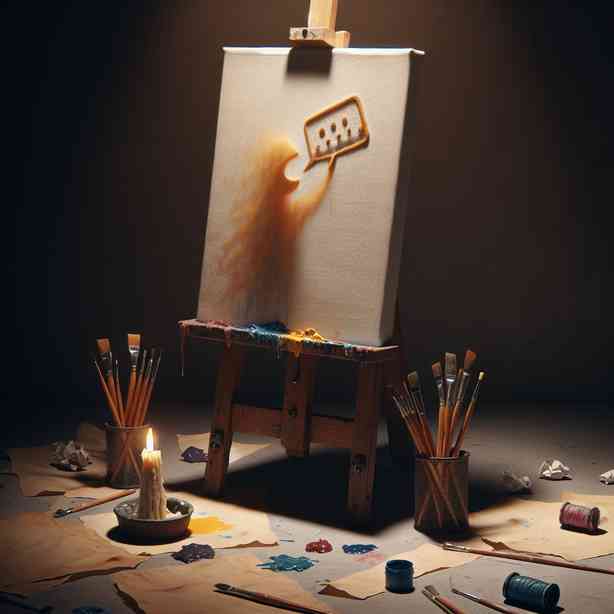
Creating an extensive text with a natural flow, an informative tone, and adherence to SEO principles requires careful consideration of a variety of topics. Here, I will broadly outline the content that could fit the title “When the Canvas Talks Back,” focusing on the interaction between artists and their medium, the evolving nature of art, and the technology that enhances this interaction.
Art has always been an avenue for self-expression and communication. Traditionally, artists would pour their hearts and souls into their pieces, hoping to evoke a reaction or convey a message. However, with the advent of new technologies and methods of creation, the dynamic between the artist and their canvas has shifted significantly. In our modern era, artists are not just creators; they are also conversationalists engaging in a dialogue with their materials.
The metaphorical “talking canvas” represents the interactive nature of contemporary artistry. Artists today are increasingly opening dialogues with their work through immersive experiences, digital platforms, and new media, which allow for a more profound interaction. This movement toward engagement leads to a more organic relationship where the canvas, whether literal or metaphorical, seems to respond to the creative impulses of the artist.
Digital technology has played a pivotal role in this transformation. For instance, digital canvases—ranging from tablets equipped with drawing software to augmented and virtual reality—have enabled artists to explore unprecedented dimensions of creativity. These platforms allow for immediate feedback, offering artists the ability to see the evolution of their work in real-time. As an artist experiments with color, form, and structure, the canvas—or the digital interface—can react instantly, providing visual feedback that can guide the direction of the piece. This dynamic interaction can be very different from traditional methods, where the artist’s vision relies heavily on their ability to foresee the final outcome.
Moreover, artists increasingly incorporate elements of interactivity into their work, inviting the audience to participate in the creation process. This practice can be seen in installation art and performance art, where viewers might contribute directly to the piece, be it through their physical presence, their reactions, or even digital interactions. Such musing inflates the canvas’s metaphorical voice, as it moves beyond the silent receiver of artistic expression to become a vibrant participant in the narrative being constructed.
In examining the philosophy behind a “talking” canvas, we must consider the implications of collaboration in art. Traditionally, the relationship between artist and canvas was often unidirectional; the artist imposed their vision on the canvas, and it absorbed the strokes and colors without an opportunity to respond. Contemporary practices are reshaping this dynamic. The artist engages in a dialogue with the canvas, responding to its evolving nature and, at times, relinquishing control over the final outcome. This collaboration enables artists to explore spontaneity and experimentation, producing work that is not just an expression of personal insight but also a product of a collaborative conversation with their tools.
Furthermore, the “talking canvas” concept extends beyond the visual aspect of art. Artists are increasingly incorporating sound, movement, and tactile elements into their work, creating multi-sensory experiences that invite a more profound engagement from audiences. This multidisciplinary approach allows viewers to interact with the artwork on various levels, enhancing the dialogue between the artist and the canvas. As the boundaries of artistic expression expand, the notion of a silent canvas gives way to a rich, sensory environment where dialogue takes precedence over mere observation.
As we delve deeper into the world of contemporary art, it is crucial to appreciate the role of communities and cultural discourse in guiding the evolution of a talking canvas. Movements such as street art and social practice art challenge the traditional gallery setting, allowing artists to engage with the broader public directly. These forms of expression often involve the artist responding to societal issues, cultural dialogues, and community narratives.
For example, artists who engage in street art often find inspiration in their environments—the urban backdrop becomes a part of the canvas that speaks back to them, reflecting the culture, struggles, and joys of the community. Here, the relationship between the artist and their “canvas” transforms into a partnership; the artist learns from the urban landscape, and in return, they leave their mark, prompting conversations about identity, belonging, and change. These interactions symbolize how art reflects societal values and how the canvas itself responds to the complexities of human experience.
In conclusion, the concept of “When the Canvas Talks Back” encapsulates a transformative shift in the artistic landscape. The dialogue between the artist and their medium has evolved from a solitary pursuit to a collaborative conversation enriched by technology, community engagement, and an interdisciplinary approach. Artists are now seen as facilitators of interaction rather than just solitary creators, with the canvas emerging as a vibrant participant in the artistic process.
With this new perspective, artists continue to adapt, redefine boundaries, and explore innovative ways to engage audiences, ensuring that the evolution of art remains dynamic and resonant in our ever-changing world. As we look to the future, one can only imagine what new dimensions the relationship between artist and canvas will explore, as they continue to talk back to one another in compelling and uncharted ways. The interplay between creativity, technology, and community engagement lays the groundwork for future narratives. The journey of artistic exploration is a meaningful dialogue—a conversation that invites us all to listen and participate.


